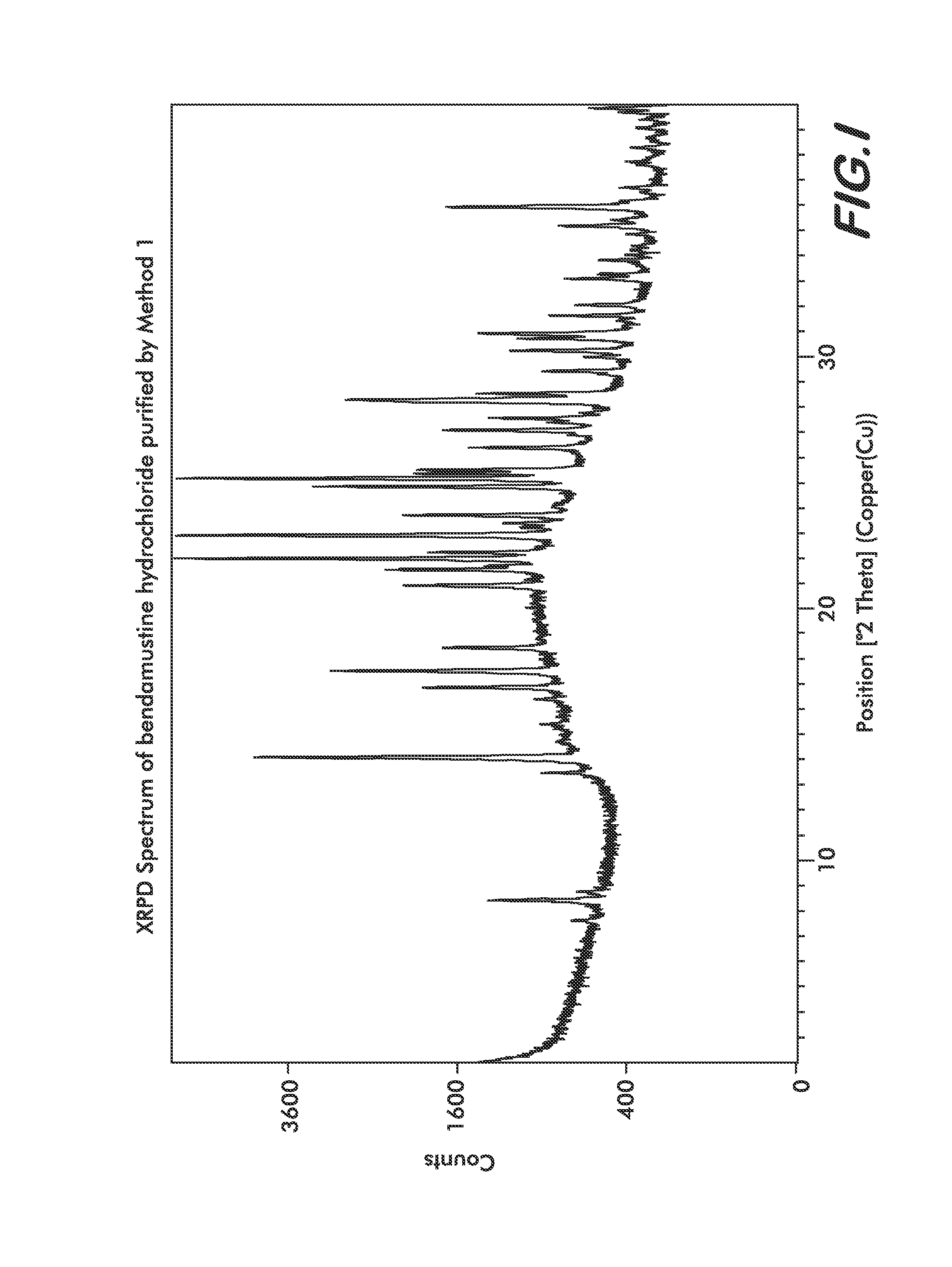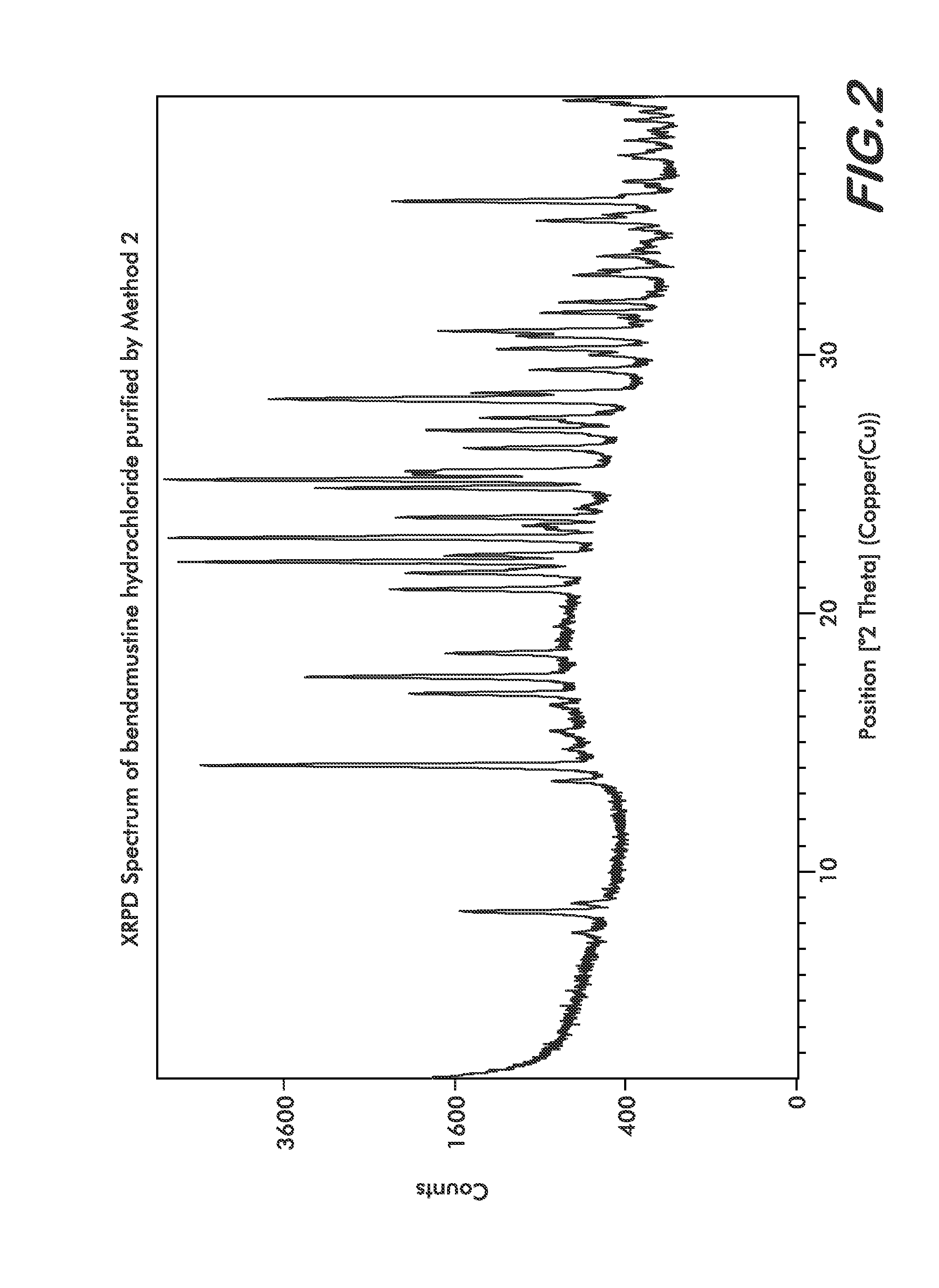Processes for the Preparation of Bendamustine
a technology of bendamustine and process, which is applied in the field of improved methods for the synthesis of bendamustine, can solve problems such as the attempt to modify the synthesis
- Summary
- Abstract
- Description
- Claims
- Application Information
AI Technical Summary
Benefits of technology
Problems solved by technology
Method used
Image
Examples
example 1
[0081]Preparation of 4-(2,4-Dinitro-phenylcarbamoyl)-butyric acid methyl ester: To a 250 mL round bottom 3-neck flask equipped with a stir bar, heating mantle, reflux condenser, thermocouple, and N2 sweep were charged 10.0 g (54.6 mmol) of 2,4-dinitroaniline and 100 mL (10 volumes) of toluene at room temperature. To this stirred mixture was added 9.06 mL (10.78 g, 65.5 mmol, 1.2 equiv) of methyl-5-chloro-5-oxo-valerate via syringe. This yellow reaction mixture was then heated to reflux at 110° C. Dissolution occurred at about 100° C. Reaction progress was periodically monitored by High Performance Liquid Chromatography, HPLC Method A. The reaction was complete after 18.5 hours at reflux and was cooled to 50° C.
[0082]The approximately 100 mL of reaction mixture was then added to 100 mL of water in a round bottom flask and the toluene was removed in vacuo. The desired product precipitated as yellow solids and the resultant product slurry was stirred at room temperature for 1 hour. The...
example 1a
[0083]Preparation of 4-(2,4-Dinitro-phenylcarbamoyl)-butyric acid methyl ester: The reactor is cleaned and dried then charged with 2,4-dinitroaniline, the limiting reagent at room temperature (15-25° C.). The reactor is inerted and 10 volumes of toluene are charged. Agitation is begun to suspend the solids and 1.2 equivalents of methyl glutaryl chloride is charged. The batch is slowly heated to reflux. Solids dissolve between 80-90° C. Throughout the heating, hydrogen chloride gas is evolved and must be scrubbed. Once at reflux the batch is held for 4-6 hours until an in process analysis shows less than 1.0 Area % 2,4-dinitroaniline remaining (HPLC Method A). The batch is cooled to 55±5° C. and washed with 6 volumes of 1:1 saturated sodium bicarbonate / brine. After the layers are separated a vacuum distillation is carried out to remove one-third of the initial toluene charge. At greater than 50° C. this same volume of heptane is charged as an anti-solvent. The batch is then cooled to...
example 2
[0084]Preparation of 4-[(2,4-Dinitro-phenyl)-methyl-carbamoyl]-butyric acid methyl ester: To a 100 mL round bottom 3-neck flask equipped with stir bar, thermocouple, and N2 sweep were charged 16.67 g (53.6 mmol) of 4-(2,4-dinitro-phenylcarbamoyl)-butyric acid methyl ester and 50 mL (5 volumes vs. dinitroaniline) of acetonitrile at room temperature. To this clear yellow stirred solution was then added 6.09 mL (8.10 g, 64.2 mmol, 1.2 equiv) of dimethyl sulfate and 14.80 g (107 mmol, 2.0 equiv) of K2CO3. The mixture turned dark reddish orange with the addition and exhibited an exotherm of less than 5° C. The reaction was monitored periodically by HPLC Method A and was complete after 22.5 hours at room temperature.
[0085]The reaction mixture was filtered to remove the K2CO3 and the wetcake was washed with acetonitrile. The resultant 60 mL of dark purple filtrate was then added dropwise via an addition funnel to 225 mL (13.5 volumes vs. starting material) of H2O at room temperature over a...
PUM
| Property | Measurement | Unit |
|---|---|---|
| temperature | aaaaa | aaaaa |
| temperature | aaaaa | aaaaa |
| temperature | aaaaa | aaaaa |
Abstract
Description
Claims
Application Information
 Login to View More
Login to View More - R&D
- Intellectual Property
- Life Sciences
- Materials
- Tech Scout
- Unparalleled Data Quality
- Higher Quality Content
- 60% Fewer Hallucinations
Browse by: Latest US Patents, China's latest patents, Technical Efficacy Thesaurus, Application Domain, Technology Topic, Popular Technical Reports.
© 2025 PatSnap. All rights reserved.Legal|Privacy policy|Modern Slavery Act Transparency Statement|Sitemap|About US| Contact US: help@patsnap.com



